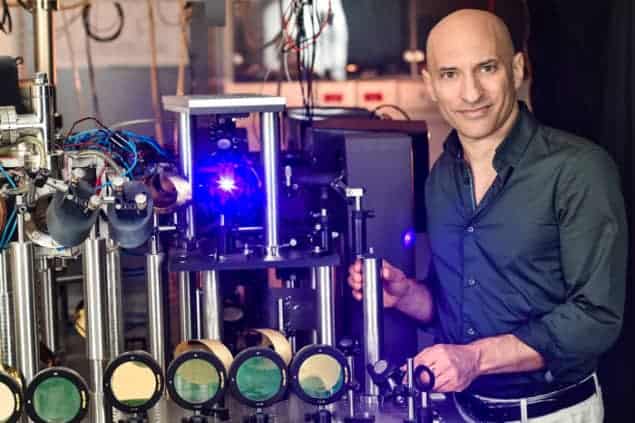
Entangled Hawking radiation emitted by an analogue black hole has been observed by a physicist in Israel. The experiment simulates the event horizon of a black hole using sound propagation in a Bose–Einstein condensate (BEC). The measurement shows that, if Einstein’s general theory of relativity holds at the boundary of a black hole, then black holes must emit radiation. Some physicists disagree, however, about whether the experiment fully validates the assumptions used to predict Hawking radiation.
In 1974 Stephen Hawking showed that general relativity and quantum field theory together suggested that photon pairs should be created at the event horizon of a black hole. One photon, carrying “negative energy”, would fall into the black hole; the other, carrying positive energy, would be emitted as radiation, giving the black hole a well-defined temperature. The theoretical implications of this are revolutionary, as it is unclear how the statistical thermodynamic definitions of temperature and entropy could apply to a black hole.
Physicists have not been able to study Hawking radiation because the temperatures of all known black holes are lower than that of the cosmic microwave background radiation. This makes their Hawking radiation effectively undetectable. However, in 1981 William Unruh of the University of British Columbia pointed out that the production of quantized sound waves – or phonons – in a BEC could be made mathematically equivalent to the predicted photon production at the event horizon of a black hole. Since then, various researchers have used this to build analogue black holes in the laboratory.
Bouncing light
In 2014 atomic physicist Jeff Steinhauer of the Israel Institute of Technology (Technion) in Haifa replicated a particular type of hypothetical black hole with two horizons in a BEC. He showed that, if radiation was excited, it would bounce between the two horizons, amplifying itself continuously to produce a type of laser. It was by no means certain that such a phenomenon could occur in a real black hole, however, as this would require radiation to travel faster than the speed of light between the horizons.
In the new research, Steinhauer has extended his model to cover the general case of a black hole. He swept a potential-energy step along a flowing BEC of rubidium-87 atoms. On one side, the flow was slower than the speed of sound in the condensate – allowing phonons to flow against the condensate. As the condensate travelled over the potential step, however, its speed became supersonic thus preventing phonons from travelling against the flow.
Steinhauer measured the spectrum of phonons in the condensate that are created by quantum density fluctuations at near-zero temperature. These are analogous to the photons created by fluctuations in the quantum vacuum (i.e. Hawking radiation) in a real black hole. The spectrum matched Hawking’s prediction. “The measurement reported here verifies Hawking’s calculation, which is viewed as a milestone in the quest for quantum gravity,” explains Steinhauer.
Fragile entanglement
Steinhauer also looked at the correlation between phonons on either side of the potential step. He found that, for all but the lowest frequencies, the correlation was too large to be due to chance. Therefore, he concluded, the phonons on either side of the step were entangled quantum mechanically. However, the degree of entanglement was less than predicted by quantum theory for most frequencies: “Entanglement is a fragile thing,” says Steinhauer, “There are several possibilities about what could destroy entanglement.” The fact that particles falling into black holes are apparently entangled with particles emitted from the surface is crucial to black hole thermodynamics, says Steinhauer, as it suggests they cannot then be entangled with each other. This rules out one possible way information could escape a black hole.
Renaud Parentani of Paris-Sud University is an expert on black hole analogues and is impressed with Steinhauer’s work: “The microscopic, detailed properties of the Hawking prediction of 1974 have now been observed in an analogue experiment,” he says. However, he is more sceptical than Steinhauer about the applicability to quantum gravity. “Sound waves in the condensate obey the same equations that Hawking used, having assumed that gravity could be treated as a passive arena,” he explains. “Therefore, by observing the phonons one indeed confirms the predictions made by Hawking, but one does not validate the assumptions used by Hawking. In fact, many physicists, in particular those working in string theory, consider that these assumptions are illegitimate because they apparently lead to the loss of information [in black holes],” he says.
The research is published in Nature Physics.



